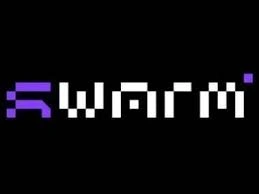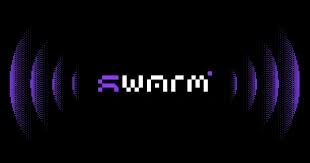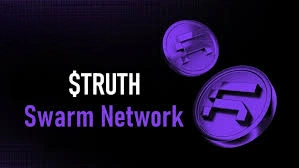Swarm Network TRUTH Protocol: On-Chain Verified Data
Table of Contents

Imagine a world where every piece of information you consume—news articles, social posts, financial signals—can be verified and anchored onchain in real time. That’s exactly what Swarm Network is building. With its TRUTH Protocol, this platform combines decentralized AI-agent swarms, human validators, and zero-knowledge proofs to create an “epistemic truth layer” for the digital age. According to the website, this framework “delivers on-chain, real-time verified data” to power next-generation dApps.
Whether you’re a crypto investor tired of FUD, a content creator seeking authenticity, or a developer pioneering Web3 applications, Swarm Network’s approach could reshape how we trust and use data. Let’s dive into the mechanics, utility, ecosystem, and future of the TRUTH Protocol—and why it matters now.
For more insights and updates on the latest trends in cryptocurrency, be sure to check out our Nifty Finances platform, which serves as your gateway to smarter financial decisions in the digital economy.

What is the Truth Protocol in Swarm Network?
The Truth Protocol sits at the heart of Swarm Network’s mission to build a “user-owned, autonomous digital economy”. In essence, it is a framework designed to verify arbitrary real-time data in a decentralized way, combining AI, human oversight, and cryptographic proof. As their website puts it:
“By combining decentralized AI-agent swarms, cryptographic techniques, and zero-knowledge proofs, the Truth Protocol delivers real-time verification of arbitrary data to power a robust new layer of dApps.”
In other words, the Truth Protocol is the infrastructure layer enabling Swarm Network to ensure that data feeding into applications (especially Web3 and AI systems) is not only timely, but trustworthy, tamper-resistant, and open to scrutiny.
Purpose & Use-Case
The core purpose of the Truth Protocol is to tackle a growing challenge: as digital systems, AI agents, and decentralized applications proliferate, the reliability of the data they consume becomes a critical bottleneck. Swarm Network sees this as both a technical and societal issue. Their mission states: “To preserve trust and truth between humans and AI.”
In practice, the protocol offers:
- A verification layer for real‐time data streams, so that applications built on top do not rely purely on oracles of questionable provenance.
- A hybrid human-AI workflow, where autonomous agent swarms process large volumes of data, and human validators provide context and oversight to improve accuracy.
- Cryptographically anchored results (via zero-knowledge proofs) to ensure the verification results themselves are tamper-resistant and provable.
By doing this, the Truth Protocol aims to enable decentralized apps (dApps) that need high-integrity data—whether for newsfeeds, marketplaces, governance systems, or other Web3 infrastructure—to work without trusting a central oracle or single point of failure.
Key Components
Here are the main pillars of the Truth Protocol:
- Decentralized AI-Agent Swarms: These are clusters of AI agents working together to ingest, analyse, and validate streams of data. Their behaviour and performance are managed via on-chain mechanisms (such as reputations) so they evolve and improve.
- Human Oversight (‘human-in-the-loop’): While AI swarms can scale to high volumes, human validators add critical judgment and contextual awareness, reducing false positives and ensuring correctness in complex cases.
- Zero-Knowledge Proofs (ZKPs) and On-Chain Anchoring: Once verification is done, results are anchored using zero-knowledge proofs onto blockchain infrastructure. This secures immutability and transparency without exposing sensitive underlying data.
- On-Chain Reputation & Verification Economy: Agent swarms carry reputations stored on-chain; their verification performance, historical accuracy, and governance metrics influence how they’re trusted and rewarded.
The Problem Addressed
Swarm Network’s Truth Protocol seeks to solve several interrelated issues:
- Misinformation and collective hallucinations: In the digital era, the volume of data and speed of propagation greatly outpace traditional fact-checking or central moderation. Swarm Network sees a truth-layer as necessary to restore trust.
- Oracle limitations: Many decentralized systems rely on oracles (trusted third parties) to feed external data. These oracles introduce single points of failure, centralisation risk, and opaque processes. Swarm’s approach aims to decentralise this.
- Trust in data infrastructure: For AI systems, Web3 apps, decentralized governance, and more—if the input data cannot be trusted, then everything built atop it becomes vulnerable. The Truth Protocol offers a foundation to build “trustworthy” systems.
The Swarm Network Truth Protocol is an ambitious infrastructure layer that combines AI-agent swarms, human validation, and cryptographic anchoring to bring verified, real-time data into decentralized applications. By addressing the problems of misinformation, oracle dependency, and data trust, it proposes a new paradigm for “truth” in the autonomous digital economy.

How It Works – The Mechanism Behind Verified Data
At the core of the Swarm Network’s Truth Protocol lies a sophisticated mechanism that turns chaotic streams of information into verified, trustworthy data. The process combines autonomous AI-agent swarms, human validators, and zero-knowledge cryptography, forming a transparent yet privacy-preserving data verification engine. Each component plays a specific role in building a decentralized “truth layer” for Web3 and AI systems.
The Workflow: From Agent Clusters to Verified Claims
The Truth Protocol’s operation follows a multi-step workflow designed to maximize both scalability and trust:
- Agent Cluster Creation – Independent AI agents are deployed to observe and analyze external data sources — whether social content, sensor data, financial feeds, or web information. These agents are not monolithic; they are modular programs trained for specific data types or domains.
- Swarm Formation – Once created, these agents dynamically form swarms — decentralized networks of cooperating AI nodes that cross-validate one another’s findings. This Swarm Network architecture removes single points of failure and allows for high throughput, ensuring no single agent controls the narrative.
- Claim Verification – Data from external sources is turned into claims that must be verified by the Swarm Network. Agents collaborate to test these claims, using both statistical analysis and cryptographic attestations. When a claim is ambiguous, the system triggers a human-in-the-loop validation step, where human participants review data and provide contextual judgment.
- On-Chain Anchoring – Once consensus is achieved, the result is encoded as a verifiable proof and anchored on-chain. This step ensures immutability — no one can alter the record — while enabling dApps and external systems to reference the verified truth as a reliable data source.
This flow transforms noisy, unverified inputs into blockchain-anchored outputs that can be trusted by autonomous systems without relying on centralized oracles.
AI Agents vs. Human Validators: Scale Meets Nuance
The Truth Protocol’s strength lies in combining machine speed with human discernment.
- AI Agents bring scale, speed, and objectivity. They can process millions of data points, perform pattern detection, and generate initial verification hypotheses. Their decentralized coordination ensures redundancy and diversity of perspective.
- Human Validators, meanwhile, bring context, ethics, and nuance. They step in for complex or ambiguous data where interpretation matters — such as verifying intent, tone, or subjective claims.
This hybrid model leverages the best of both worlds: AI for scalable computation, and human intelligence for final assurance. The result is a verification process that is both fast and contextually accurate.
Cryptographic Trust: Zero-Knowledge Proofs & On-Chain Reputation
To secure its verification layer, the Truth Protocol uses zero-knowledge proofs (ZKPs) — cryptographic techniques allowing data validation without revealing the data itself. This ensures:
- Privacy – sensitive data can remain encrypted while still being proven valid;
- Integrity – verification results cannot be tampered with post-confirmation;
- Transparency – anyone can verify the proof’s authenticity without accessing the underlying information.
Complementing this is an on-chain reputation system, where each AI swarm and human validator accumulates a track record of accuracy. Reputation scores influence future participation, ensuring incentive alignment — those who provide reliable verification earn higher trust and rewards, while inaccurate participants lose standing.
The Truth Protocol operates as a decentralized consensus engine for verified information. By fusing scalable AI intelligence, human insight, and cryptographic assurance, Swarm Network creates a resilient infrastructure that can authenticate data in real time — without sacrificing privacy or decentralization.

Core Features and Benefits
The Truth Protocol by Swarm Network isn’t just another blockchain data oracle — it’s a complete, decentralized infrastructure for verified information in real time. Built on a foundation of AI-agent swarms, human oversight, and cryptographic assurance, it offers a next-generation framework for data trust, automation, and economic collaboration. Its features are designed not only for developers and data scientists, but also for communities, DAOs, and enterprises that rely on reliable digital truth to operate effectively.
Real-Time Data Streams and Verification at Scale
One of the defining strengths of the Truth Protocol is its ability to handle real-time data verification. Traditional oracles or centralized data feeds often introduce latency and trust issues, but Swarm Network’s decentralized AI swarms continuously process live information from multiple sources.
- Scalable Verification: Swarm-based parallelization means thousands of agents can evaluate claims simultaneously, making the protocol capable of handling the massive data throughput of social networks, markets, or IoT systems.
- Instant Proof Anchoring: Once verification consensus is achieved, proofs are instantly recorded on-chain, ensuring immutable and time-stamped trust records.
- Autonomous Adaptation: Agent clusters self-adjust to new data environments, retraining and optimizing themselves as new patterns or information sources emerge.
The outcome is a live, scalable “truth engine” that can serve as a backbone for dApps and AI-driven systems requiring accurate and verified inputs.
No-Code Tools for Agent and Swarm Creation
Swarm Network lowers the barrier to participation through no-code tools that allow users to create, configure, and deploy agent clusters without deep technical expertise. This democratizes access to AI and blockchain technology, fostering a diverse ecosystem of contributors.
- Visual Interfaces: Intuitive dashboards and modular templates enable users to build or customize AI-agent swarms with drag-and-drop functionality.
- Plug-and-Play Integration: Developers can connect data sources or APIs to existing swarms through simplified workflows.
- Community Templates: Pre-built agent configurations for common verification tasks—like news validation or DeFi data tracking—help new users get started quickly.
By making swarm creation accessible, Swarm Network encourages innovation from a broader community, from independent developers to data researchers and decentralized organizations.
Decentralized Governance, Monetization, and Shared Ownership
Swarm Network’s ecosystem is designed around shared ownership and decentralized governance. Each swarm functions like a micro-economy where participants contribute, validate, and earn rewards based on their performance and accuracy.
- On-Chain Governance: Token holders can propose, vote on, and implement changes to swarm behavior or verification parameters.
- Monetization Mechanisms: Verified data outputs can be sold or licensed to external applications, allowing swarm participants to earn from their contributions.
- Shared Ownership: The decentralized nature of swarms ensures that no single entity can monopolize data verification, maintaining open participation and transparency.
This structure transforms data verification from a service into a participatory economy, where both AI and human contributors benefit directly from maintaining truth and integrity.
Real-World Use Cases
The versatility of the Truth Protocol unlocks diverse applications across Web3 and AI ecosystems:
- Fact-Checking Social Media: Swarms can monitor and validate trending posts, flagging misinformation in real time.
- DeFi Analytics: Reliable, verified data streams can feed into on-chain financial dashboards or trading algorithms.
- DAO Governance: Decentralized organizations can rely on verified information to make proposal decisions or resource allocations.
- Token Launch Ecosystems: New projects can integrate Truth Protocol verification for transparent metrics, investor trust, and fair token distribution.
Swarm Network’s Truth Protocol provides a scalable, inclusive, and economically aligned framework for verifying real-time data. Its combination of no-code accessibility, decentralized ownership, and cryptographic trust establishes a new standard for transparency in digital ecosystems — where truth becomes a shared, verifiable asset rather than a centralized privilege.
How to Get Involved & What’s Next
The Swarm Network ecosystem is built for participation — where users, developers, and investors can all take part in building and maintaining the global layer of verified truth. Whether you want to deploy your own agent swarm, contribute to existing ones, or simply explore the ecosystem’s growth opportunities, the Truth Protocol provides multiple ways to engage.
Steps to Get Involved
Becoming part of the Truth Protocol starts with owning or operating an AI agent — the backbone of Swarm’s decentralized verification process. Here’s how you can begin:
- Acquire an Agent License
To join the network, users must first obtain an Agent License. This license authorizes participation in the verification process and grants access to tools that manage AI-agent clusters. Think of it as your entry point into Swarm’s “truth economy.” Licenses can be staked or activated depending on your chosen level of engagement — from passive leasing to active management. - Lease to the Truth Swarm
For users who prefer passive participation, Swarm Network allows leasing of licensed agents to existing Truth Swarms. In this model, your agents contribute compute and validation power while earning a share of the swarm’s rewards. Leasing provides a lower-risk way to participate without directly managing AI logic or data pipelines. - Build Your Own Swarm
Advanced users and developers can go further by creating their own verification swarm. Using Swarm Network’s no-code interface and Gitbook documentation, you can define your swarm’s parameters, verification goals, and data sources. Each swarm can specialize — for example, focusing on fact-checking, DeFi metrics, or NFT authenticity — and then publish verified outputs for the ecosystem. Building a swarm also allows you to attract collaborators, contributors, and clients seeking verified data services.
What’s Coming Next
Swarm Network’s roadmap outlines a steady expansion of both tools and ecosystem functionality, with several key developments on the horizon:
- Agent BUIDL Platform: A new toolkit under development that will let creators design and deploy custom AI agents through an intuitive, no-code interface. It aims to lower the barrier for AI development within the Truth Protocol.
- New Swarm Launches: Specialized verification swarms focused on different domains — including social media truth detection, Web3 project analytics, and governance data — are scheduled for release.
- Expanding Ecosystem Integrations: Swarm is actively developing partnerships to integrate verified data feeds into DeFi platforms, DAOs, and decentralized social networks.
- Gitbook and Developer Resources: Updated documentation and tutorials are being rolled out to help users build agents and manage licensing with greater transparency and ease.
These updates will make it simpler for both technical and non-technical participants to build, verify, and monetize truth data across decentralized systems.
Tips for Crypto Investors and Developers
For those looking to participate in Swarm Network as investors or builders, a few best practices apply:
- Assess Token Utility: Understand the role of any associated token — whether it’s used for staking, governance, or rewarding verification accuracy — before making commitments.
- Verify the Roadmap: Use the Swarm Gitbook and community channels to review development milestones and check for active progress.
- Participate Early, but Responsibly: Early adoption can offer strong network positioning, but always manage exposure carefully, diversify holdings, and stay updated on ecosystem developments.
The Swarm Network’s Truth Protocol is more than a data system — it’s a collaborative movement toward verified, autonomous, and transparent information in Web3. By joining as an agent operator, swarm builder, or informed investor, you contribute to a decentralized foundation of truth that could redefine how AI and blockchain interact in the years to come.
In a world flooded by data, misinformation, and broken trust systems, Swarm Network’s TRUTH Protocol offers something new: a decentralised, transparent, and scalable way to verify information. By combining AI agents, human insight, and on-chain anchoring, it doesn’t just ask “is this true?” — it builds a system where truth is verifiable, monetised, and owned by its participants.
Whether you’re a developer looking to launch a swarm, an investor seeking next-gen utility, or simply someone who wants to trust what you read, Swarm Network has a seat at the table. Dive in, evaluate the ecosystem, and decide how you’ll participate—because the future of verified data is being written now. In a world where big tech holds the keys to our data, Vana (VANA) is building a different path, one where you own your data, not corporations.